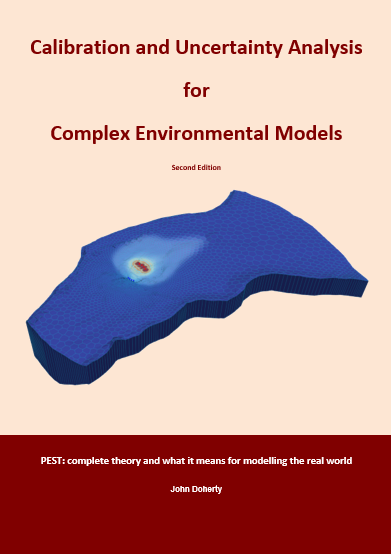Calibration and Uncertainty Analysis for Complex Environmental Models: Second Edition
 Much has changed since the release of the first edition of this book in 2015. The second edition covers advances in theory and methodologies that have appeared since then, and that are now supported by PEST, PEST++ and their ancillary software suites.
Much has changed since the release of the first edition of this book in 2015. The second edition covers advances in theory and methodologies that have appeared since then, and that are now supported by PEST, PEST++ and their ancillary software suites.
However the book covers way more than just theory. It explains what the theory means. It draws conclusions from the theory about how real-world decision-support modelling should be done, including construction, history-matching and deployment. Though not always in agreement with "conventional" environmental modelling practice, these conclusions are logical and well explained. They just make sense!
Topics covered in the book include, but are not limited to:
- basics of linear algebra
- basics of statistics
- calibration and regularization
- linear uncertainty and error analysis
- ensemble-based uncertainty analysis and the iterative ensemble smoother (IES)
- ensemble space inversion (ENSI)
- data space inversion (DSI)
- new and old ways to use pilot points
- stationary and nonstationary stochastic field generation and manipulation
- hierarchical history-matching (inversion and Bayesian)
- repercussions of model defects for decision-support modelling
- the journey of information from data to decisions
- preventing information from becoming disinformation
Knowledge of all of the above topics is essential to modern-day decision-support modelling. No other book discusses them all in one place. Whether you are a modeller, or a modelling stakeholder, you are sure to benefit from reading this book.
Download the book by clicking here.
Suggested citation.
Doherty, J., 2025. Calibration and Uncertainty Analysis for Complex Environmental Models. Second Edition. Watermark Numerical Computing, Brisbane, Australia. ISBN:978-0-9943786-1-3.
(Readers should note that the page size in the book PDF is A4 (8.27 x 11.69 inches). If printing from the PDF file to 8.5 x 11 inch paper, the page scaling option “Fit to Printable Area” is recommended.)
